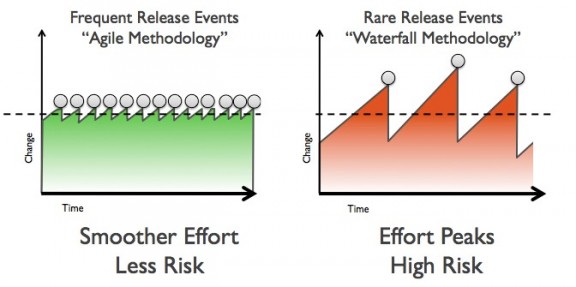Enterprise IT departments are in the middle of a tremendous flux.
One of IT’s primary mandates is to maintain security, reliability and scalability of backbone IT systems that run the business. The maintenance aspect of IT eschews experimentation and innovation and lays emphasis on following set procedures and routines.
Because many of these legacy applications often have a convoluted code base, IT teams have a “if it’s not broken don’t fix it” philosophy. This might result in business users demanding but not getting features and tools they need.
This logjam gives rise to shadow IT, where business units use third party applications without the consent of IT to get the job done. Shadow IT can cause serious security and governance issues as critical data flows out of corporate networks.
The Bimodal scenario
One way CIOs can resolve these issues is make a part of the enterprise IT department agile. This organizational model is what Gartner refers to as Bimodal IT. While there has always been some sort of division of labor between development and maintenance in enterprises this trend is becoming more prominent in many enterprises as well as in smaller businesses.
Essentially Bimodal IT works like this:
Mode 1 is that part of the organization that works to maintain the backend and the core IT systems and applications that run the business. The mode 1 team is in charge of maintenance and business as usual functions and essentially keeps the lights on.
Mode 2 deals with everything shiny and new. Think cloud computing, BYOD, mobility, and application development driven by user and market needs. This part of the enterprise IT department is wedded to speed and looks like a startup, adopting new age development methodologies like DevOps and Agile.
The difference in the two modes looks like this (image courtesy Wikipedia)
In theory Bimodal IT sounds like a neat solution but it comes with a number of challenges.
- Clean divisions might be hard to implement
Systems of record and systems of engagement have to co-operate to make the customer experience worthwhile. The interface of an insurance app may be updated and well designed but if it takes too long to query information from the backend it will be of no use. IT leaders will need to make sure that mode 1 and mode 2 teams work together, and that could be a massive hurdle given the contrasting philosophies they work under.
- There will be conflict over resources and budgets
The focus of traditional IT teams is very different, and accordingly budget allocations are also tailored according to their needs. For instance, well entrenched IT teams will look to increase resources in maintaining legacy applications and in setting up more captive data centers. On the other hand, mode 2 leaders will want more resources devoted towards building new applications that can be hosted on clouds. There will also be conflicts over the speed and pace of development in areas where mode 1 and mode 2 teams have to collaborate.
These conflicts will have to be addressed on a case by case basis so that the business doesn’t suffer.
- Transition from new to mature processes will be a challenge
Once a Mode 2 process or application is sufficiently mature it may be moved to core IT. For example a bank which runs a successful pilot project around a mobile banking app will want to roll it out to all customers once user feedback is accounted for. But Mode 1 teams, so far accustomed to maintaining core banking solutions might not be up to the challenges of maintaining a customer facing mobile app which needs frequent updates and is built using completely new frameworks and technologies.
For cloud based applications, using an approach where the production environment is run concurrently with the live environment and traffic shifted from one environment to the other based on results of different tests can be a solution.
Way forward for enterprise IT
In a world where IT is increasingly being commoditized adopting the bimodal approach can help CIOs maintain the relevance of the department within the enterprise. Bimodal IT can help in reducing churn rate and stop the talent hemorrhage as employees who are interesting in cutting edge tech needn’t have to perform maintenance tasks.











